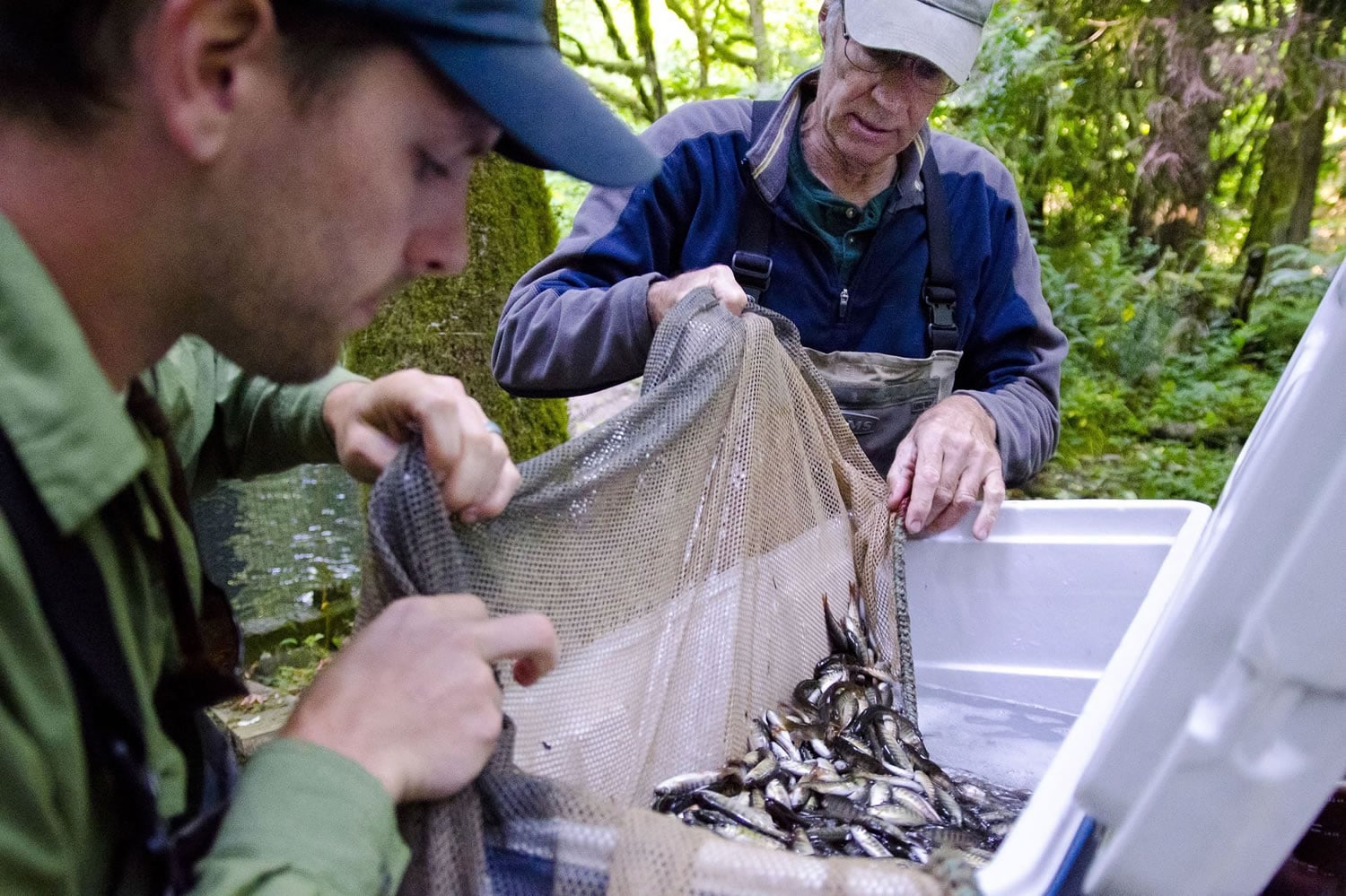Dave Brown admits he’s not great at counting fish. He tends to guess low.
When he looked into the biggest pond holding wild fish at his home outside Battle Ground last month, he pegged the number at about 22,500. Maybe higher.
At least this much is clear:
“I’m overcrowded,” Brown said. “I can hold a lot of little fish. But when they get big, I can’t hold them.”
To volunteer or donate to Northwest Wild Fish Rescue, contact the organization at 360-687-7049. More information is available at http://www.nwwildfishrescue.org/.
Brown runs Northwest Wild Fish Rescue, a one-of-a-kind operation that captures young coho salmon and steelhead from waterways where they would otherwise become stranded and die when the water drops or dries up. Brown holds them and raises them in several pens on his property — fed by an elaborate system of pipes tapping natural spring water — before releasing them back into various parts of the Salmon Creek watershed when water is higher. The goal is to improve ailing wild fish runs in area waterways once bursting with them.
The process has worked well enough that Brown and his team pulled their biggest count ever this year — now estimated at as many as 30,000 total fish in Brown’s pens.
But that meant a change of plans. Northwest Wild Fish Rescue this week released at least 4,000 juvenile coho salmon into Upper Salmon Creek. Keeping them too long would have meant overcrowding the fish as they grew in coming months, Brown said.
Brown used this week’s release as a teaching moment. He invited a handful of volunteers to help out, offering a hands-on lesson in the process.
“This kind of program without outreach is pointless,” said Brice Crayne, a field technician with Clark Public Utilities and one of Brown’s trusted assistants with Northwest Wild Fish Rescue.
Outreach and education has been more of a focus recently for Northwest Wild Fish Rescue, which filed as a nonprofit organization last year.
But volunteers didn’t get a leisurely nature walk this week. They came to work, and Brown expected nothing less.
“Dave is so passionate about what he does,” Crayne said. “That’s what it takes to have a program like this.”
Carefully executed
John DiVittorio began Wednesday’s carefully executed operation by tossing a couple handfuls of fish food into Brown’s biggest pond. As the water suddenly bubbled with a dark cloud of fish at the surface, Brown and Crayne scooped a large net under them. They pulled up thousands, weighing down the net. Too many for this load.
The two dumped some back in, then transferred the rest to a cooler waiting on Brown’s four-wheeler. Brown drove the load of about 1,500 coho up a trail to a 300-gallon water tank — filled to match the temperature of the pond — waiting in the driveway. A pump kept water trickling into the tank, and oxygen for the fish with it.
After two more loads in the tank, Brown and his crew headed for Upper Salmon Creek in the High Valley area east of Battle Ground. Once there, volunteers carried buckets of fish to different parts of the creek, gently lowering them in. They also tossed in “analog” pellets to boost nutrients in the fish’s new home.
Most volunteers had never worked with Brown before. Nor had they seen anything like Northwest Wild Fish Rescue.
“I think it’s really interesting,” said Stephan Clement of Camas, a recent Union High School graduate. “I didn’t really know anything like this existed.”
Volunteers spread fish over about a mile of Salmon Creek. The operation picked up steam as the morning went on, with workers gradually moving downstream while Brown’s truck and the tank of fish jumped ahead to meet them with more fish. Local residents and property owners joined them along the way.
The salmon didn’t miss a beat. Some instantly locked into the current, swimming perfectly in place after leaving a bucket. Others went on their way.
Most of the fish will remain in the area through the summer and winter, Brown said. When it’s time, they’ll attempt to make their way to the Pacific Ocean before eventually returning to spawn.
Only a small fraction of salmon complete that journey. But incomplete data still being collected show Brown’s wild fish, some recently tagged as part of a four-year study, have returned at a good rate. Others have been caught as far away as Depoe Bay, Ore., and outside Puget Sound, he said.
‘Little treasures’
This week’s release ended at a covered bridge over Salmon Creek, accessible only by horse trails. DiVittorio corralled the last fish from the tank, and the day’s work was done. The group took a moment to take in a little-known gem, standing inside the bridge.
“You think you know an area, and you keep finding little treasures like this,” said La Center resident Marti Larsh. “This is great.”
The release was the first of many thousands of fish that will be put back into the Salmon Creek watershed by early next year. Brown hopes he can also raise awareness of the stream system that holds more fish than many people realize.
Progress is welcome, but Brown doesn’t hide the reality that Salmon Creek’s fish counts are nothing compared to what they used to be. Even longtime residents here today remember a very different waterway decades ago.
“Why do you think it’s called Salmon Creek?” Brown said. “Good reason.”
Eric Florip: 360-735-4541 or eric.florip@columbian.com.




